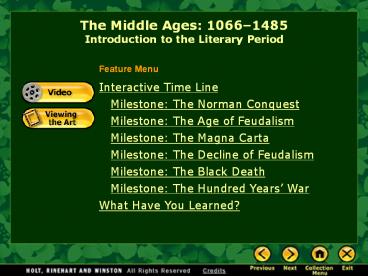The Middle Ages: 1066 - PowerPoint PPT Presentation
Title:
The Middle Ages: 1066
Description:
The Middle Ages: 1066 1485 Introduction to the Literary Period Feature Menu Interactive Time Line Milestone: The Norman Conquest Milestone: The Age of Feudalism – PowerPoint PPT presentation
Number of Views:357
Avg rating:3.0/5.0
Title: The Middle Ages: 1066
1
The Middle Ages 10661485Introduction to the
Literary Period
Feature Menu
Interactive Time Line Milestone The Norman
Conquest Milestone The Age of Feudalism
Milestone The Magna Carta Milestone The
Decline of Feudalism Milestone The Black
Death Milestone The Hundred Years War What
Have You Learned?
2
The Middle Ages 10661485
Choose a link on the time line to go to a
milestone.
1066 Norman Conquest
13481349 Black Death
1215 Magna Carta
13371453 Hundred Years War
1200
1100
1500
1300
1000
1400
1300s1400s Decline of Feudalism
1000s1300s Age of Feudalism
3
The Norman Conquest
William the Conqueror
- a duke from Normandy, France
- claimed the English throne had been promised to
him
In 1066 . . .
- crosses the English Channel with a huge army
- defeats King Harold at the Battle of Hastings
4
The Norman Conquest
The Normans Change England
- land divided among Williams followers from
Normandy
- more contact with European civilization
- a new languageFrench
- a new social systemfeudalism
5
The Age of Feudalism
Feudalism
- social, property, and military system
- based on a religious concept of rank
- some vassals appointed by king in return for
loyalty
- lords (powerful vassals) appoint their own
vassals
6
The Age of Feudalism
Knights in Shining Armor
- provided military service to lords
- often the sons of nobles
- began training at an early age
- wore very heavy armor into battle
- followed a code of chivalry
7
The Age of Feudalism
Code of Chivalry
A code of conduct that covered
- whom to defendknights lord, the king, and the
Christian faith
- how to treat a ladycourtly love
- how to help others
- how to resist the urge to run away if captured
8
The Age of Feudalism
Courtly Love
The knight
- adored the lady and was inspired by her
- glorified the lady in words
The lady
- remained pure and out of reach
- was set above her admirer
9
The Age of Feudalism
The Romance
- new genre of literature
- inspired by legends of chivalrous knights
- hero goes on quest to conquer evil enemy
- hero often has magical help
- includes stories of distant, idealized courtly
love
10
The Age of Feudalism
The Crusades (10951270)
- series of holy wars
- waged by European Christians against Muslims in
the Middle East
- ultimately unsuccessful
- Europeans benefit from contact with Arab
civilization
11
The Age of Feudalism
Benefits to Europeans from Crusades
Examples of sophisticated culture to which
Europeans were exposed include
- public libraries in Damascus and Baghdad
- wealthy cities such as Cairo providing links to
spice trade
- universities such as Al-Azhar University in
Cairo, one of the oldest universities in the world
- medical knowledgefirst accurate study of
smallpox and measles
12
The Magna Carta
1215
- Magna CartaGreat Charter
- signed by King John, under pressure from English
barons
- protected rights of aristocrats
- meant a return to more democratic tendencies
13
The Decline of Feudalism
Growth of Cities and Towns
- townspeople not tied to masters land or to
knighthood
- merchant classpeople earn their own money
- city peoples tastes influence artsballads,
miracle plays, and so on
14
The Decline of Feudalism
Monetary System
Before the Crusades
After the Crusades
- foreign coins are melted down
- gold coins are used
- peasants can earn gold in exchange for labor or
goods
- few coins exist
- feudal lords make coins for use on their own
property only
- peasants can save money, have greater buying and
selling power
- serfs use barter system
15
The Black Death
13481349
Black Death (bubonic plague)
- highly contagious and fatal disease, spread by
the fleas on infected rats
- factor in decline of feudalism
16
The Black Death
- The symptoms of the bubonic plague included
- blotches on the skin
- hardening and swelling of the glands under the
armpit or in the groin - delirium
- insanity
Death strangling a victim of the plague. From the
Stiney Codex. Czeckoslovakia, 14th century.
17
The Hundred Years War
13371453
- war between England and France
- England unsuccessful
- leads to British national consciousness
Yeoman
- small landowners with longbows
- begin to become dominant force (instead of
knights)
18
What Have You Learned?
Match the cause to its effect.
Cause
Effect
__________ A labor shortage gives serfs more
bargaining power. __________ The English are
exposed to Eastern cultures and
knowledge. __________ Yeomen replace knights as
main military group.
Black Death
The Crusades
Hundred Years War
19
END
20
Viewing the Art
The Middle Ages
This illustration from the Golf Book of Hours
shows peasants taking a break from their work in
the fields.
Activity What elements in the illustration
suggest that it is a romanticized view of peasant
life?
21
(No Transcript)































